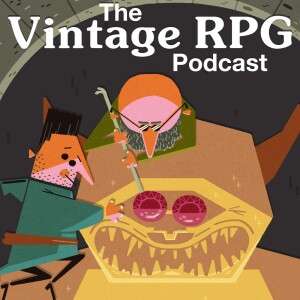Teenage Mutant Ninja Turtles and Other Strangeness
 2018-10-15
2018-10-15
It begins with a pizza joke, naturally (00:30).
The guys talk about the Choose Your Own Adventure: House of Danger board game (01:15) and Stu breaks down the basics (01:46). They discuss the stupidity of group decision making (03:00) and where to get it (05:00).
Conversation turns to the main event: Teenage Mutant Ninja Turtles and Other Strangeness (05:39). Stu admits to not being a TMNT fan (05:54) and Hambone sketches out the basic history of the franchise (06:20). Stu talks about the (07:09) original TMNT comic book series, which Palladium Books licensed almost immediately for an RPG (07:53). Stu recounts how Palladium’s license of Robotech led to the development of the TMNT cartoon and, ironically, the downfall of the TMNT RPG line (08:43).
Stu talks a bit about the (complicated) TMNT RPG system, which is a component of Palladium’s Megaversal house system (10:55). He falls into the trap of trying to explain the Megaversal system and eventually gets to TMNT’s juicy center: the mutation rules and the After the Bomb campaign setting. (14:40).
The guys talk about the rarity of the book (15:53), in particular the very first edition of TMNT and Other Strangeness that contained controversial mental illness rules (16:13). Cowabunga.
Hambone gets excited about Pocket Dungeon Quest (17:20) and he walks through its charms (cloth map!)(17:45)
See ya next time! (21:22)
*
Clarification: We tend to use “Choose Your Own Adventure” as a catch-all term for pick-your-path game books but, like iPods and Kleenex, that’s actually a brand name for the series published by Bantam Books in the 80s and 90s. The Marvel and Dungeons & Dragons gamebooks Hambone mentions were published by TSR (the latter known as the Endless Quest series).
Correction: Stu is totally wrong, TMNT did not start off as a Daredevil pitch, it was a conscious parody of Daredevil (and also Ronin, Cerebus and New Mutants, apparently) from the get-go.
More Episodes
 2023-04-24
2023-04-24
 2023-04-17
2023-04-17
 2023-04-10
2023-04-10
 2023-04-03
2023-04-03
 2023-03-27
2023-03-27
 2023-03-20
2023-03-20
 2023-03-13
2023-03-13
 2023-03-06
2023-03-06
 2023-02-27
2023-02-27
 2023-02-20
2023-02-20
 2023-02-13
2023-02-13
 2023-02-06
2023-02-06
 2023-01-30
2023-01-30
 2023-01-23
2023-01-23
 2023-01-16
2023-01-16
 2023-01-09
2023-01-09
 2023-01-02
2023-01-02
 2022-12-26
2022-12-26
 2022-12-19
2022-12-19
 2022-12-12
2022-12-12
Create your
podcast in
minutes
- Full-featured podcast site
- Unlimited storage and bandwidth
- Comprehensive podcast stats
- Distribute to Apple Podcasts, Spotify, and more
- Make money with your podcast
It is Free
- Privacy Policy
- Cookie Policy
- Terms of Use
- Consent Preferences
- Copyright © 2015-2024 Podbean.com





